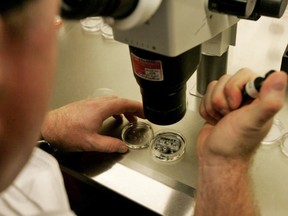Science
Scientists Transform Skin Cells into Fertilizable Eggs in Lab Breakthrough

Scientists have achieved a groundbreaking milestone by successfully converting human skin cells into fertilizable eggs and fertilizing them with sperm in a laboratory setting. This achievement, announced on March 15, 2024, could potentially revolutionize reproductive options for individuals facing infertility, a condition that impacts approximately one in six people globally.
The research team, led by experts from the United States, cautioned that while this technology, known as in-vitro gametogenesis (IVG), holds promise, it remains years away from being accessible to prospective parents. Paula Amato, a co-author of the study and researcher at Oregon Health & Science University, expressed optimism about the implications for individuals who are unable to conceive naturally.
Implications for Infertility and Same-Sex Couples
The ability to create eggs from skin cells could change the landscape of infertility treatments. Amato noted that the technology may allow older women and those who lack viable eggs for various reasons to have genetically related children. Additionally, it could enable same-sex couples to conceive a child that is genetically linked to both partners, further expanding family-building options.
In recent years, significant advancements have been made in reproductive technology. Notably, Japanese researchers announced in July 2023 that they had produced mice using DNA from two biological fathers. The current study, published in the prestigious journal Nature Communications, marks a significant advancement by applying similar principles to human DNA.
The researchers employed a technique known as somatic cell nuclear transfer, which involves removing the nucleus from ordinary skin cells and transferring it into a donor egg that has had its nucleus extracted. This method was also famously utilized in the cloning of Dolly the sheep in 1996.
Despite the promising results, a significant challenge remains. Human skin cells contain 46 chromosomes, while eggs only have 23. The research team developed a process termed “mitomeiosis” to address this issue, allowing them to successfully reduce the chromosome count to the necessary number. They generated 82 developing eggs, referred to as oocytes, which were then fertilized through in vitro fertilization (IVF).
After six days of development, less than nine percent of the embryos reached a stage suitable for transfer to the uterus in a typical IVF procedure. Although this success rate was low, the researchers pointed out that in natural reproduction, only about one-third of embryos achieve the IVF-ready “blastocyst” stage.
Future Prospects and Ethical Considerations
Amato estimated that widespread availability of this technology is at least a decade away, emphasizing that the primary challenge lies in producing genetically normal eggs with the correct number and complement of chromosomes.
Ying Cheong, a reproductive medicine researcher at the University of Southampton in the United Kingdom, praised the achievement as “exciting.” She highlighted the significance of demonstrating that DNA from ordinary body cells can be effectively placed into an egg, activated, and have its chromosomes halved, mimicking the natural processes that create sperm and eggs.
While this research represents a significant step forward, other scientists are exploring different approaches to generating eggs in the laboratory. One alternative method involves reprogramming skin cells into induced pluripotent stem cells, which can then be transformed into eggs. Amato noted that it remains uncertain which technique will ultimately prove more successful, reinforcing the idea that considerable research lies ahead.
The study adhered to existing U.S. ethical guidelines governing the use of embryos, ensuring that safety and ethical considerations remain paramount as this area of research advances. As scientists continue to explore the frontiers of reproductive technology, the potential to redefine infertility and expand family-building options remains a hopeful prospect for many.
-

 Education2 months ago
Education2 months agoBrandon University’s Failed $5 Million Project Sparks Oversight Review
-

 Lifestyle3 months ago
Lifestyle3 months agoWinnipeg Celebrates Culinary Creativity During Le Burger Week 2025
-

 Science3 months ago
Science3 months agoMicrosoft Confirms U.S. Law Overrules Canadian Data Sovereignty
-

 Health3 months ago
Health3 months agoMontreal’s Groupe Marcelle Leads Canadian Cosmetic Industry Growth
-

 Science3 months ago
Science3 months agoTech Innovator Amandipp Singh Transforms Hiring for Disabled
-

 Technology3 months ago
Technology3 months agoDragon Ball: Sparking! Zero Launching on Switch and Switch 2 This November
-

 Education3 months ago
Education3 months agoRed River College Launches New Programs to Address Industry Needs
-

 Technology3 months ago
Technology3 months agoGoogle Pixel 10 Pro Fold Specs Unveiled Ahead of Launch
-

 Technology1 month ago
Technology1 month agoDiscord Faces Serious Security Breach Affecting Millions
-

 Business2 months ago
Business2 months agoRocket Lab Reports Strong Q2 2025 Revenue Growth and Future Plans
-

 Science3 months ago
Science3 months agoChina’s Wukong Spacesuit Sets New Standard for AI in Space
-

 Education3 months ago
Education3 months agoAlberta Teachers’ Strike: Potential Impacts on Students and Families
-

 Technology3 months ago
Technology3 months agoWorld of Warcraft Players Buzz Over 19-Quest Bee Challenge
-

 Business3 months ago
Business3 months agoNew Estimates Reveal ChatGPT-5 Energy Use Could Soar
-

 Business3 months ago
Business3 months agoDawson City Residents Rally Around Buy Canadian Movement
-

 Education3 months ago
Education3 months agoNew SĆIȺNEW̱ SṮEȽIṮḴEȽ Elementary Opens in Langford for 2025/2026 Year
-

 Technology1 month ago
Technology1 month agoHuawei MatePad 12X Redefines Tablet Experience for Professionals
-

 Technology3 months ago
Technology3 months agoFuture Entertainment Launches DDoD with Gameplay Trailer Showcase
-

 Business3 months ago
Business3 months agoBNA Brewing to Open New Bowling Alley in Downtown Penticton
-

 Technology3 months ago
Technology3 months agoInnovative 140W GaN Travel Adapter Combines Power and Convenience
-

 Technology3 months ago
Technology3 months agoGlobal Launch of Ragnarok M: Classic Set for September 3, 2025
-

 Science3 months ago
Science3 months agoXi Labs Innovates with New AI Operating System Set for 2025 Launch
-

 Technology3 months ago
Technology3 months agoNew IDR01 Smart Ring Offers Advanced Sports Tracking for $169
-

 Technology3 months ago
Technology3 months agoDiscover the Relaxing Charm of Tiny Bookshop: A Cozy Gaming Escape










